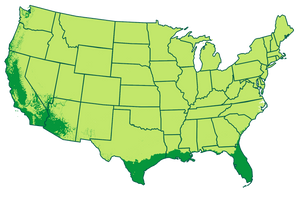* Images shown are of mature plants

Have questions? Talk with our Plant Experts (800) 973-8959
Harvest Tons of Sweet, Tart, and Unique fruit
The Tamarind Tree is a landscaping favorite because this tree has a unique vase shape and a thick canopy filled with pairs of leaves that give it an exotic look. In the winter, pale green flowers emerge, adding bursts of color to the landscape before turning into tan seedpods.
The tan pods contain an edible fruit pulp that’s juicy, sweet and tangy. The pods have thin shells so you can go out to your tree daily during the summer and crack open a few pods for a rich and refreshing snack.
Tamarinds are most popular for eating fresh, but they are also used in a variety of culinary dishes all over the world. Tamarinds are used to flavor jams and sauces like BBQ sauce. The sweet yet tart flavors complement meats, stir-fries and curry well. It’s also popular to flavor homemade beverages and to make desserts like ice cream.
If you live outside of the Tamarind’s recommended growing zones 9-11, place your tree in a container and keep it indoors during the colder months. This tropical tree variety will brighten up any room of the house while flowering and fruiting.
The Tamarind is low maintenance and easy to care for when planted in the ground or in a container. They’re drought tolerant and will grow in areas with a lot of humidity. Tamarinds are strong trees that will thrive in coastal areas with their high level of wind resistance and salt tolerance.
Pollination Info
Tamarind Tree Pollination
Tamarind Trees are self-fertile. You will get fruit with only one plant. However, adding an additional Tamarind Tree will drastically increase the size of your crop.
Planting & Care
1. Planting: Start by choosing an area with full to partial sun (4 to 8 hours of sunlight daily) and well-drained soil for your Tamarind Tree. It will also need some protection from the cold while young, so if you're in a colder climate, plant your Tamarind in a container to bring indoors during the winter.
Dig a hole that's large enough to accommodate the tree's root ball, backfill the soil and water to settle the roots. Also, mulch the surrounding soil, ensuring the mulch does not touch the trunk. This helps preserve moisture.
If you're container-planting your Tamarind, select a pot that's about twice the size of your tree's shipped container, use organic planting mix and place your tree in the pot. Place in a sunny area on your porch or in front of a sunny window indoors. Also, ensure your pot has drainage holes.
Note: This product grows best in well-draining soil. When you receive your plant, you may notice small, white beads or rocks in the soil - this medium is added to increase drainage and keep your plant happy and healthy!
2. Watering: Water once a week during the Tamarind's growing season, gradually tapering through the fall and winter. Only water to moisten dry soil - if you're not sure when the soil is dry, simply use your index finger to check the soil about 2 or 3 inches down.
3. Fertilizing: Apply a slow-release 8-3-9 fertilizer during early spring for the first three to five growing seasons. Follow the label directions, and water deeply after fertilizing.
4. Pruning: Prune Tamarinds in late winter with pruning shears. During the first two years, choose 3 to 5 strong, evenly spaced branches for scaffolding (or, cutting upwards at a 45-degree angle). Cut all other branches back nearly to the trunk. After that, simply remove dead or weak branches yearly.
Shipping Details
Estimated Shipping Time: Most orders ship immediately. As noted on the website, some items are seasonal, and may only ship in spring or fall. Once your order is shipped, you'll receive an email with a tracking number.
| Amount of Order | Shipping Charge |
|---|---|
| Less than $49 | $19.95 |
| $49 + | FREE SHIPPING! |
Product Details
| Mature Height: | 15-25 ft. |
| Mature Width: | 20-35 ft. |
| Sunlight: | Full-Partial |
| Growth Rate: | Moderate Growing |
| Harvest Time: | Varies |
| Botanical Name: | Tamarindus Indica |
| Does Not Ship To: | AK, AZ, DC, HI |
| Grows Well In Zones: | 3-11 patio / 9-11 outdoors |
| Your Growing Zone: | # |







